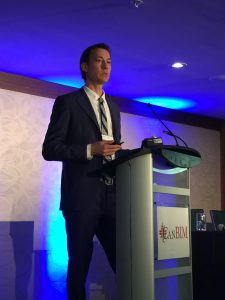Vancouver is aiming for zero operational greenhouse gas (GHG) emissions by 2030 from new buildings using high-tech solutions like Building Information Modeling (BIM) and the simplicity of Passive House design.
City of Vancouver assistant director of sustainability Brad Badelt opened the second day of the CanBIM Vancouver Sustainability through BIM Innovation conference, held Feb. 8 in downtown Vancouver.
Badelt spoke about the City of Vancouver’s Zero Emissions Building Plan, an initiative to derive 100 per cent of the energy used in Vancouver from renewable sources before 2050 as well as reduce GHG emissions by 80 per cent below 2007 levels before 2050.
Vancouver, he said, is uniquely positioned to tackle sustainability as the city is already 31 per cent renewable. The electrical supply, he said, is already 100 per cent renewable unlike many coal-dependent east coast cities.
But 57 per cent of Vancouver’s carbon pollution comes from buildings, he said.
The Renewable City Strategy target is for new buildings to be zero-emission by 2030 or earlier. The provincial and federal government have similar goals and “this is as real economic opportunity for Vancouver to lead,” Badelt said.
By 2050, Vancouver’s building stock will consist of 30 per cent pre-2010 built forms, which are the most difficult to make zero emission. About 30 per cent are at current and upcoming standards and 40 per cent of buildings can get to 2050 standards, he said.
The Zero Emissions Building Plan, Badelt said, has four components. It limits GHG, heat loss and total EUI limits down until zero emissions. Through leadership, he said, city-owned buildings are required to be zero emission.
Incentives include supporting private sector leadership and capacity building means investing in tools to “develop and share knowledge and to remove barriers,” he said.
To limit GHGs and heat loss, a fundamental restriction of energy efficiency is required, with a focus on improved envelope and ventilation.
“BIM will be a critical tool,” he said. “It’s highly unlikely developers will be able to hit our goals without using BIM in a comprehensive way.”
Vancouver is the only city that requires embodied energy to be reported and Badelt said air tightness is becoming a much more important component, though awareness of its importance remains low.
“If we’re going to meet targets, we need to get underway right now,” Badelt explained, pointing to eight city facilities starting design and construction to Passive House standards.
Six out of 29 rezoning applications received since May 2017 were also for Passive House, he said.
Future building practice “takes envelope performance for its final steps, increases pre-fab and modular construction and requires better design and construction co-ordination,” he stated.
Adopting Passive House and focusing on air tightness can be complicated and difficult, he added, and BIM is a vital tool to deal with those challenges.
The city will establish a Zero Emission Building Centre for Excellence, Badelt said, to facilitate peer-to-peer knowledge sharing, create a curated research library and “connect academia and industry. It’s a vital cog and we’re glad that it’s launched.”
The city is currently consulting with stakeholders and is working with the Vancouver Regional Construction Association, Passive House Canada and the Open Green Building Society to develop and launch the centre.
“BIM is an obvious thing to bring to that centre, so it should be a really good fit,” Badelt added.
Attitudes have also changed across industry and government to the point where zero emission goals seem achievable, he said.
When the plan was announced in 2015 during the Paris Climate Agreement, “people looked at it as pie in the sky,” Badelt said.
But in the meantime many cities across North America and Europe have also committed to 100 per cent renewable use.
“It’s been a huge shift in only two years time,” Badelt said.












Recent Comments